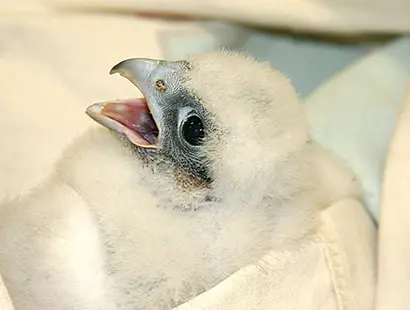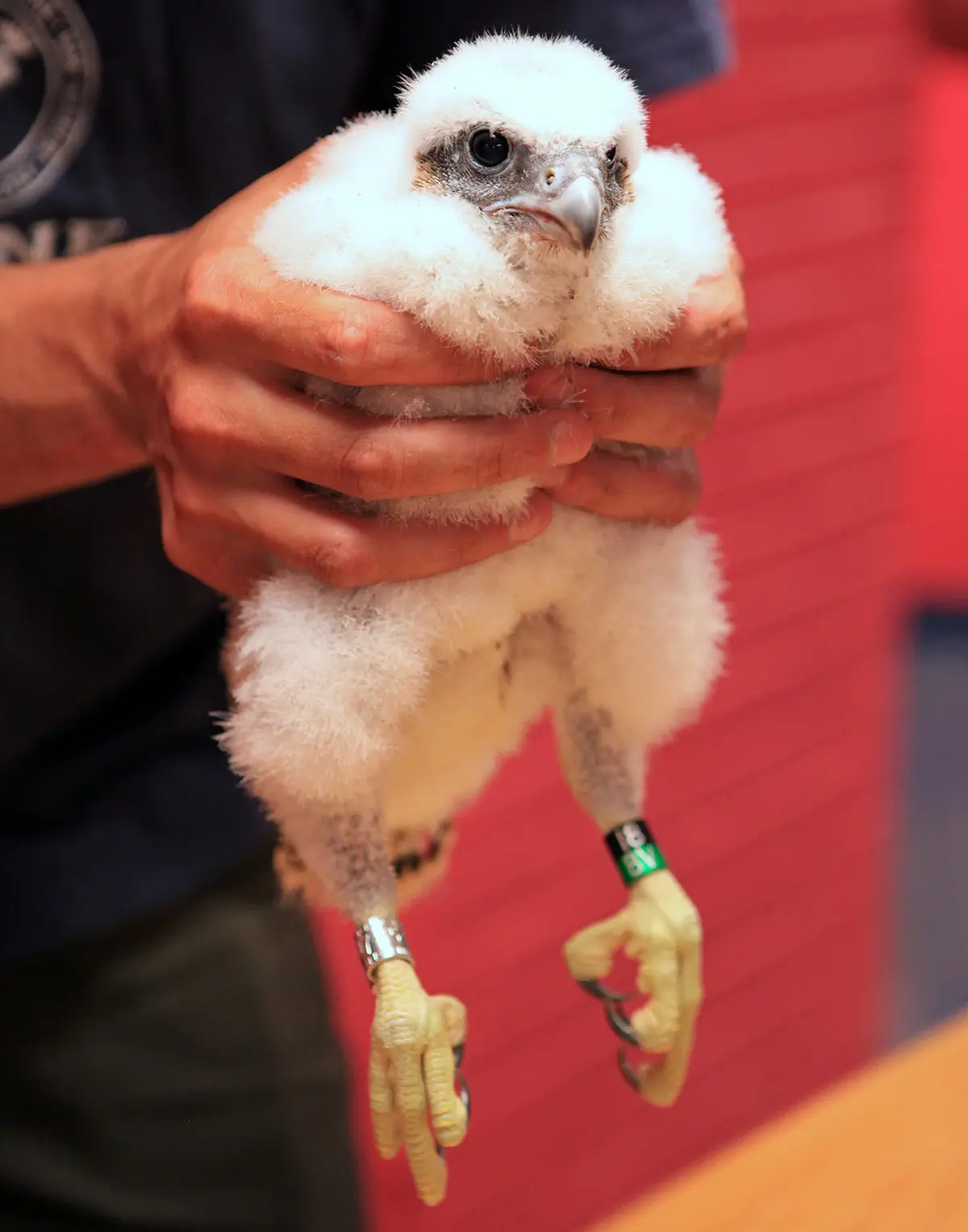Want to learn more about birds, helping animals and the environment?
About Peregrine Falcons
It’s the fastest animal on the plant, capable of speeds of up to 200 miles per hour. It mates for life—about ten years—and is fiercely protective of its young. The peregrine falcon belongs to the genus Falco, which is characterized by long pointed wings.
- Sound (Call)
- Size and Shape
- Habitat
- Diet
- Migration
- Reproduction
- Endangered Status
- Banding
- Fun Facts
- Helpful Links
SoundSound (Call)
Peregrine falcons are birds of few words; they are generally silent but sometimes make a rasping kack-kack-kack-kack sound in the nest.Take a listen.
SizeSize and Shape
The peregrine falcon is a crow-sized bird, weighing just over two pounds with a wing span of approximately 3 feet. It can weigh between 1 and 3.5 pounds and measure between 13 and 20 inches long. An adult peregrine has a dark grey back and crown, dark bars or streaks on a pale chest and abdomen, and heavy malar (cheek) stripes on the side of the face. Immature peregrines are buff colored in front and have dark brown backs. Females and males are identical in appearance; however, the female can be one-third larger than the male.
HabitatHabitat
Peregrine falcons are skilled at catching a variety of prey from small songbirds to large ducks, which allows them to live in almost any type of climate and habitat. They are found in deserts, seashores, wetlands, tundra, grasslands, dry forests and craggy mountains. Peregrine Falcons live and breed on every continent in the world except Antarctica.
They also manage quite well in urban settings—such as the pair who nest on the roof of Fox Hall.
Once established, the adults will remain in the same territory year-round.
Like most falcons, Peregrine Falcons do not build their own nests. They lay their eggs in scrapes, or small depressions, that they make in the soil or gravel of a cliff ledge. The pair atop Fox Hall nest in a box with gravel floor built by UMass Lowell staff under the guidance of the Massachusetts Division of Fisheries and Wildlife.
DietDiet
Peregrine Falcons are mainly bird hunters; starlings, pigeons, blackbirds, jays, shorebirds, and waterfowl are all fair game for a hungry Peregrine Falcon. They also occasionally hunt mammals, reptiles and insects, and there have even been reports of some Peregrine Falcons specializing in eating bats. They typically catch their prey in the air with fast pursuits, rapid dives and other impressive aerial maneuvers for which these falcons are known and admired.
Perhaps its most famous hunting technique is the dive. To pull this off, a Peregrine Falcon flies high into the sky, using its keen eyesight to locate birds flying below. When it finds its target, the falcon folds its wings and falls into a nose dive, or stoop, gaining speeds over 200 mph. The falcon closes its feet, and uses them to knock the prey out of the sky.
MigrationMigration
The Peregrine Falcon is one of 26 North American species considered to be a partial migrant. Individuals typically follow the same route year after year. In eastern North America, the outbound and return routes of some individuals follow an elliptical path in which individuals travel south along the East Coast and return north along the Gulf Coast. UMass Lowell’s falcons usually stay in the area year-round. Their offspring can normally be found within Eastern Massachusetts. In previous years, some of them have been sighted in beaches and marshes as far north as Plum Island and as far south as Plymouth and Chatham. One was even spotted at Green Airport in Rhode Island.
ReproductionReproduction
 Peregrine falcons mate for life, but if one of the mates dies, it gets replaced right away. They are able to reproduce starting at one to three years old. Male Peregrine Falcons bring females food during the courting and nesting season. By early March the adult pair has chosen its nest for the season. Between three and five eggs are laid around the beginning of April; the chicks hatch in early May after a month-long incubation.
Peregrine falcons mate for life, but if one of the mates dies, it gets replaced right away. They are able to reproduce starting at one to three years old. Male Peregrine Falcons bring females food during the courting and nesting season. By early March the adult pair has chosen its nest for the season. Between three and five eggs are laid around the beginning of April; the chicks hatch in early May after a month-long incubation. To date, the Fox Hall falcons have successfully raised a total of 15 chicks—12 on campus, and, prior to that, three in an abandoned mill building in downtown Lowell.
EndangeredEndangered Status
 Image by Imelda Joson
Image by Imelda Joson
The Peregrine Falcon Color Banding Protocol in North AmericaBanding
Content via United States Geological Survey
There is an international protocol in North America for colored leg bands on Peregrine Falcons. The color indicates the origin or subspecies for chicks banded in the nest. The colors in the protocol and their meaning are:
- Red Captive bred
- Black/red bicolor Eastern United States
- Black/green bicolor Eastern United States
- Blue Tundra Peregrines
- Black/blue bicolor Tundra or Anatum captured off the breeding grounds or subspecies unknown
- Green Peale's Peregrines
- Black Anatum Peregrines
Characters used on the Peregrine bands are letters and numbers, with one character on the top of the band and one character on the bottom of the band. Older bands may have these characters either vertical or tipped ninety degrees to the left. Newer bands have all vertical characters.
As unique codes for each color are exhausted, the codes are repeated with a 1 mm white line separating them. The color band codes on Peregrines are unique and tied to an individual bird and band number. These bands can be read on a perched bird with the aid of a telescope.
Be sure to report the codes as you saw them (vertical and tipped characters, presence or absence of a white line, band color, code color).
Fun Facts
- Like many raptors, Peregrine Falcon females are larger than the males.
- Peregrine Falcons were once were called duck hawks.
- The word “peregrine” is Latin for migrant or wanderer.
- The Peregrine Falcon is famous for its fast flying. Biologists have clocked it diving at speeds of over 200 mph.
- Peregrine Falcons are one of the most popular birds in the sport of falconry, and in ancient times were considered the birds of royalty.
- Peregrine Falcons are sometimes flown by their trainers at airports to scare off ducks and other birds that could collide with a plane and cause accidents.
- American Birding Association
- American Society for the Prevention of Cruelty to Animals (ASPCA)
- Massachusetts Division of Fisheries & Wildlife (MassWildlife)
- Massachusetts Natural Heritage & Endangered Species Program - (MassWildlife)
- Massachusetts Society for the Prevention of Cruelty to Animals (MSPCA)
- National Audubon Society
- The Royal Society for the Protection of Birds (RSPB) page on falcons
- Massachusetts Audubon Society (Mass Audubon)
- New Hampshire Audubon Society (NH Audubon
- Rare Bird Conservation in Massachusetts - (MassWildlife)
- UMass Lowell Climate Change Initiative
- United States Geological Survey (USGS)
- University of Massachusetts, Amherst Falcon Cams (atop Du Bois Library)
